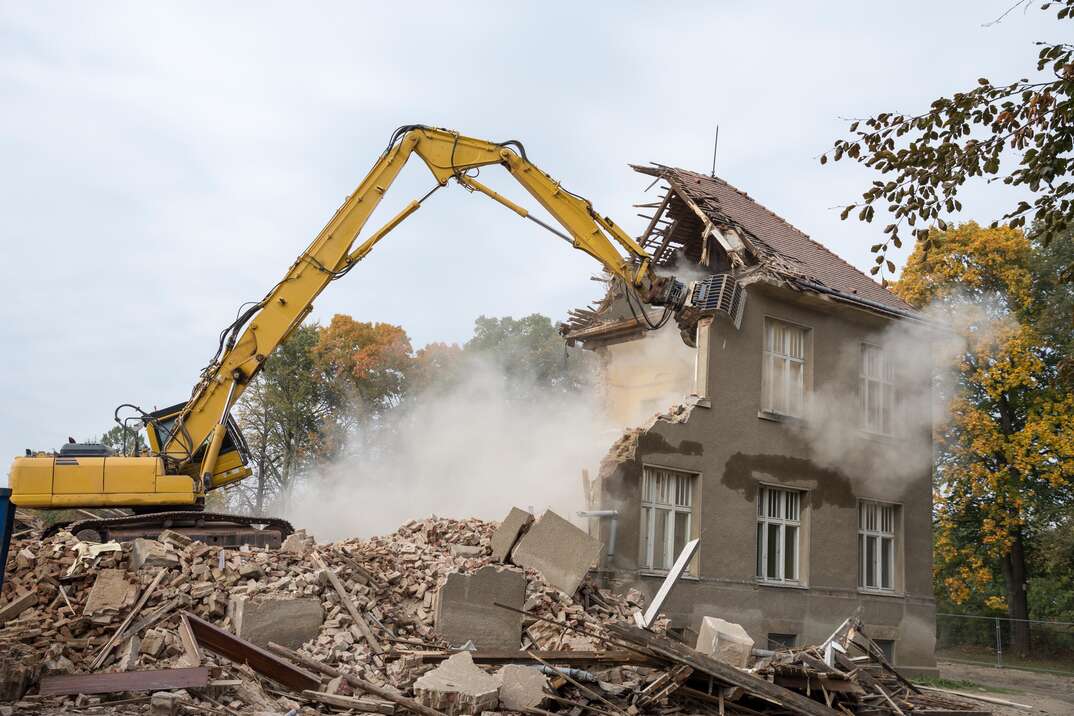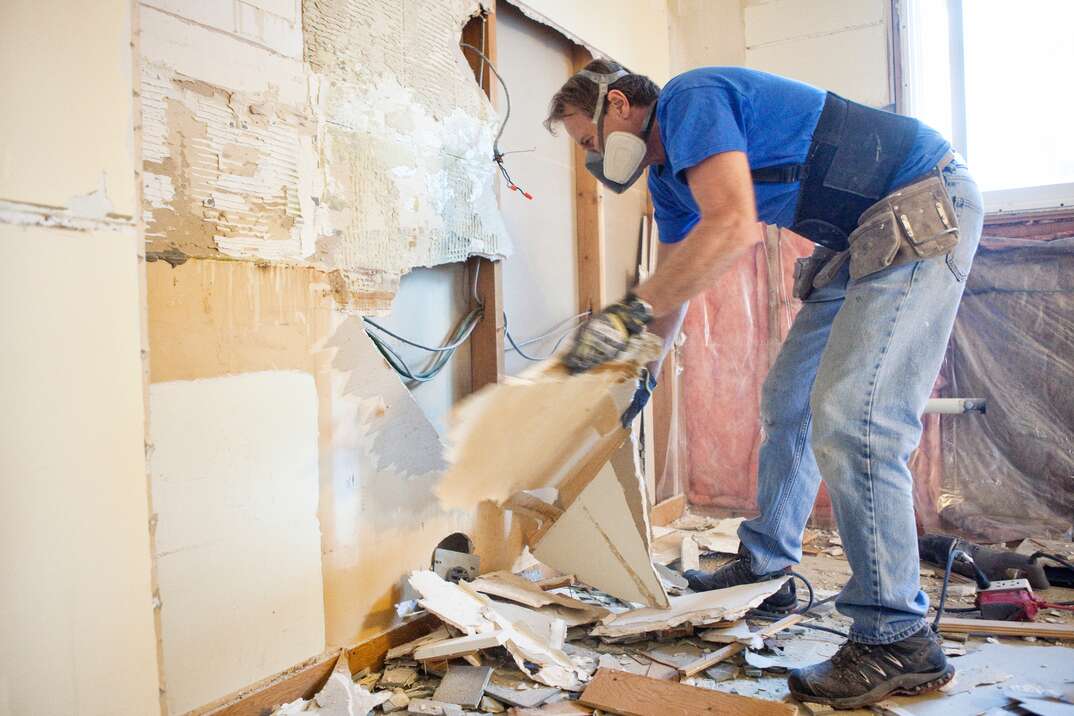Tear the House Down: A Guide to House Demolition

Preparing for a House Demolition at a Glance
- Step 1: Contact mortgage lender
- Step 2: Get estimates from contractors
- Step 3: Obtain permits
- Step 4: Contact utility companies
- Step 5: Check for hazardous materials
People tear down homes and other properties for many reasons. After a natural disaster or fire, some houses are just too damaged to rehab. The cost of taking the house down to the bare bones and remodeling may not make practical financial sense. Perhaps you just purchased a piece of property with an abandoned or neglected structure, and you just want to start over. Regardless of the reason, a whole-house demolition is not as simple as breaking down walls; it can be a complex undertaking that requires some careful planning.
This May Also Interest You: How to Remove a Tile Floor
Is it time for your house or other structure to go? Read on to learn the basics of home demolition.
Demolition Methods
There are two general approaches to tearing down a house: deconstruction and mechanical demolition. Deconstruction is just what it sounds like ─ taking the house apart by hand. Mechanical demolition means the building is completely razed, typically using heavy machinery. Debris is then hauled away by truck or dumpster. Sometimes, demolition contractors will use a combination of the two methods and remove items that are valuable or can be repurposed, such as copper pipes, lumber and working light fixtures.
 -------------------------------------------
-------------------------------------------
Can You Demolish a House Yourself?
The short answer? Yes. However, you’ll need to do some prep before you begin any demo work — so don’t start swinging your sledgehammer just yet. It’s critical to follow certain steps for safety purposes and to align with local regulations. It’s also important to consider whether you have the time, skills and resources to take on a whole-house demolition.
Steps to Take Before Starting House Demolition
Planning ahead is key to a smooth home demolition process. Following these steps can help you save time, money and headaches:
Call Your Mortgage Lender
Unless you own the property outright, you’ll need to notify your lender of your intent to demolish your house. Lenders have a vested interest in the properties that they finance. Failing to get permission for a house demolition can result in your lender demanding immediate payment in full on your mortgage. Each loan contract is different, so it’s best to contact your lender to go over the details.
Get Estimates From Demolition Contractors
Even if you want to take on the job yourself, it’s always a good idea to contact a few licensed demolition contractors to get an idea of how much the demo will cost. Typically, you can expect to pay anywhere from $5,000 to $15,000 or more for larger buildings. Make sure to get at least three quotes from contractors who specialize in demolition.
When you consider the amount of time it will take, the cost of equipment, permits and other factors, you may find that hiring a demo contractor wouldn’t cost that much more than doing it yourself.
Obtain Proper Permits
Whether you need a permit to demolish your house depends on where you live. In urban, suburban and some rural areas, you’ll need to get a permit from the local building department or housing authority before you tear down a house. This is one step you don’t want to skip. If city or county officials find out you’re doing the work without a permit, the process will be halted. You may also face hefty fines.
If you’re using a demolition contractor, find out if they will obtain these permits for you as part of the project cost. Contractors often have connections at local building departments that can expedite the process.
Contact Utility Companies
Gas, water and electricity must be properly disconnected and terminated at the source before the demolition process can begin. In some areas, the fire department or another authority may need to perform an inspection to ensure utilities are properly disconnected.
Check for Hazardous Materials
Asbestos, lead paint and other hazardous materials used in older constructions must be handled and disposed of properly. If asbestos was used in your home’s flooring, ceilings or insulation, it’s best to have professionals remove it to avoid airborne asbestos exposure. Proper mold removal is also a must to avoid becoming ill or injured.
More Related Articles:
- Out With the Mold and in With the New: How to Clean Mold
- How Much Does a Mold Inspection Cost?
- What Is a Home Improvement Loan and How Do You Get One?
- How Much Does a Kitchen Remodel Cost?
- How Much Does a Basement Remodel or Renovation Cost?
How to Tear Down a House
Once you’ve taken care of all the required preliminary tasks, it’s time to get busy tearing down the house. Demo contractors often use a combination of manual deconstruction and mechanical demolition, using equipment such as hydraulic excavators and other heavy machinery.
How a house is torn down often depends on the condition of the property, materials used in its construction, local building regulations, whether you plan to rebuild and other factors specific to the situation.
Deconstruction
Deconstruction is the best way to salvage as many materials inside the home as possible. According to the EPA, when a home is deconstructed, up to 70% of the building materials may be recycled or reused. If wood, doors and windows are in good condition, you may want to look into donating, selling or even reusing them if you plan to build a new home.
Although deconstruction is more environmentally friendly, it takes much longer than other methods and can cost significantly more. To deconstruct a house by hand, you will definitely need some help from handy friends, family members or professionals.
Keep these tips in mind while you’re going through the process:
- Starting from the top, remove shingles and underlayment on the roof. Then, remove skip sheathing and plywood. If you’re throwing demolition materials on the ground or into a dumpster, make sure to avoid hitting anyone working below.
- Remove interior fixtures, including plumbing, electrical, doors, windows, cabinetry and flooring. Again, all utilities must be properly shut off and disconnected before taking this step.
- Methods for removing drywall and plaster vary. Generally, striking it with a sledgehammer or crowbar and pulling it away until all studs are exposed works well. Do not remove load-bearing wall studs or supports until the second floor and roof are completely deconstructed.
- If you have interior or exterior brick you want to salvage, using a chisel to remove each brick is your best bet. You should be able to pop off exterior siding fairly easily.
- The method for removing the roof will depend on how the house was constructed and the materials that were used.
- Disposing of all materials properly is a must. Using a roll-off container that’s loaded onto a truck is usually the easiest way to get rid of them. Check local regulations for disposing of hazardous materials like fluorescent lights.
- Although the foundation can be broken up and removed manually, having a professional use a hydraulic excavator to dig out the foundation and or basement is recommended.
Hiring a Demolition Contractor
If you don’t have the time or inclination to deal with the painstaking process of deconstructing or demolishing your home, hiring a reputable demolition contractor is the way to go. A good contractor will answer any questions you have and provide a certificate of insurance before starting demolition work. It’s also important to discuss their safety policies, whether they’ll obtain necessary permits and how long the demo will take. If there are specific materials or items you want to recycle or repurpose, make sure to give them a list.
Since we’re all home now more than ever, being prepared for unexpected home repairs with a plan from HomeServe is important. Having a plan in place gives you peace of mind knowing that you can simply call our 24/7 repair hotline for covered breakdowns. See what plans are available in your neighborhood.


